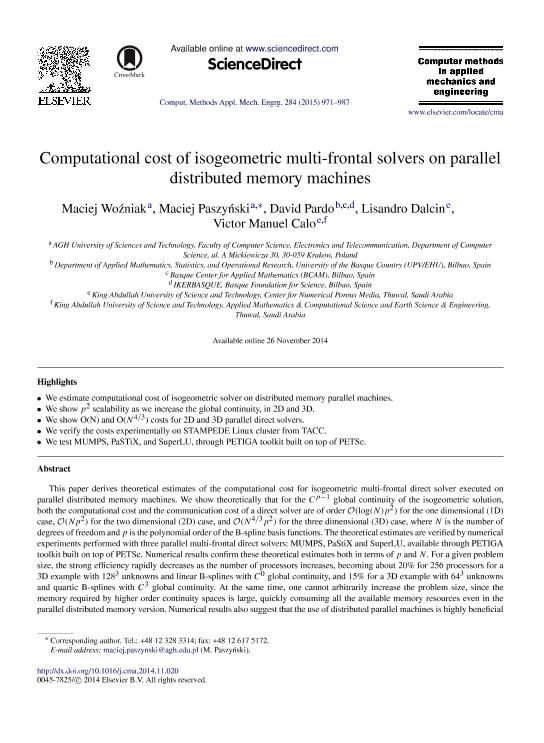Mostrar el registro sencillo del ítem
dc.contributor.author
Wozniak, Maciej
dc.contributor.author
Paszynski, Maciej
dc.contributor.author
Pardo, David

dc.contributor.author
Dalcin, Lisandro Daniel

dc.contributor.author
Calo, Victor Manuel
dc.date.available
2019-06-21T01:40:36Z
dc.date.issued
2015-02
dc.identifier.citation
Wozniak, Maciej; Paszynski, Maciej ; Pardo, David; Dalcin, Lisandro Daniel; Calo, Victor Manuel; Computational cost of isogeometric multi-frontal solvers on parallel distributed memory machines; Elsevier Science Sa; Computer Methods in Applied Mechanics and Engineering; 284; 2-2015; 971-987
dc.identifier.issn
0045-7825
dc.identifier.uri
http://hdl.handle.net/11336/78612
dc.description.abstract
This paper derives theoretical estimates of the computational cost for isogeometric multi-frontal direct solver executed on parallel distributed memory machines. We show theoretically that for the Cp-1 global continuity of the isogeometric solution, both the computational cost and the communication cost of a direct solver are of order O(log(N)p2) for the one dimensional (1D) case, O(Np2) for the two dimensional (2D) case, and O(N4/3p2) for the three dimensional (3D) case, where N is the number of degrees of freedom and p is the polynomial order of the B-spline basis functions. The theoretical estimates are verified by numerical experiments performed with three parallel multi-frontal direct solvers: MUMPS, PaStiX and SuperLU, available through PETIGA toolkit built on top of PETSc. Numerical results confirm these theoretical estimates both in terms of p and N. For a given problem size, the strong efficiency rapidly decreases as the number of processors increases, becoming about 20% for 256 processors for a 3D example with 1283 unknowns and linear B-splines with C0 global continuity, and 15% for a 3D example with 643 unknowns and quartic B-splines with C3 global continuity. At the same time, one cannot arbitrarily increase the problem size, since the memory required by higher order continuity spaces is large, quickly consuming all the available memory resources even in the parallel distributed memory version. Numerical results also suggest that the use of distributed parallel machines is highly beneficial when solving higher order continuity spaces, although the number of processors that one can efficiently employ is somehow limited.
dc.format
application/pdf
dc.language.iso
eng
dc.publisher
Elsevier Science Sa

dc.rights
info:eu-repo/semantics/openAccess
dc.rights.uri
https://creativecommons.org/licenses/by-nc-sa/2.5/ar/
dc.subject
Communication Cost
dc.subject
Computational Cost
dc.subject
Isogeometric Analysis
dc.subject
Multi-Frontal Direct Solver
dc.subject
Parallel Distributed Memory Machine
dc.title
Computational cost of isogeometric multi-frontal solvers on parallel distributed memory machines
dc.type
info:eu-repo/semantics/article
dc.type
info:ar-repo/semantics/artículo
dc.type
info:eu-repo/semantics/publishedVersion
dc.date.updated
2019-06-19T16:53:58Z
dc.journal.volume
284
dc.journal.pagination
971-987
dc.journal.pais
Países Bajos

dc.journal.ciudad
Amsterdam
dc.description.fil
Fil: Wozniak, Maciej. Agh University Of Science And Technology; Polonia
dc.description.fil
Fil: Paszynski, Maciej. Agh University Of Science And Technology; Polonia
dc.description.fil
Fil: Pardo, David. Universidad del Pais Vasco - Euskal Herriko Unibertsitatea, Campus Bizkaia; España
dc.description.fil
Fil: Dalcin, Lisandro Daniel. Consejo Nacional de Investigaciones Científicas y Técnicas. Centro Científico Tecnológico Conicet - Santa Fe. Centro de Investigaciones en Métodos Computacionales. Universidad Nacional del Litoral. Centro de Investigaciones en Métodos Computacionales; Argentina
dc.description.fil
Fil: Calo, Victor Manuel. King Abdullah University Of Science And Technology; Arabia Saudita
dc.journal.title
Computer Methods in Applied Mechanics and Engineering

dc.relation.alternativeid
info:eu-repo/semantics/altIdentifier/doi/http://dx.doi.org/10.1016/j.cma.2014.11.020
Archivos asociados
